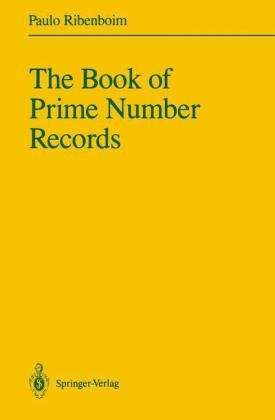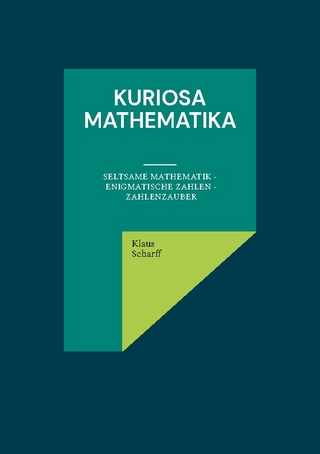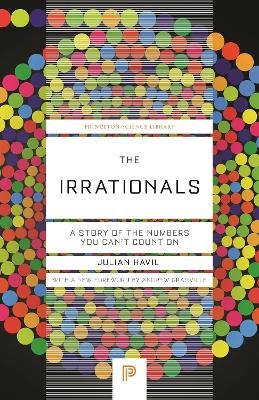
The Book of Prime Number Records
Springer-Verlag New York Inc.
978-0-387-96573-4 (ISBN)
- Titel ist leider vergriffen;
keine Neuauflage - Artikel merken
I wish to express my appreciation for the great care, speed, and competence of her work. Paulo Ribenboim CONTENTS Preface vii Guiding the Reader xiii Index of Notations xv Introduction Chapter 1. How Many Prime Numbers Are There? 3 I. Euclid's Proof 3 II.
1. How Many Prime Numbers Are There?.- I. Euclid's Proof.- II. Kummer's Proof.- III. Polya's Proof.- IV. Euler's Proof.- V. Thue's Proof.- VI. Two-and-a-Half Forgotten Proofs.- A. Perott's Proof.- B. Auric's Proof.- C. Metrod's Proof.- VII. Washington's Proof.- VIII. Furstenberg's Proof.- 2. How to Recognize Whether a Natural Number Is a Prime?.- I. The Sieve of Eratosthenes.- II. Some Fundamental Theorems on Congruences.- A. Fermat's Little Theorem and Primitive Roots Modulo a Prime.- B. The Theorem of Wilson.- C. The Properties of Giuga, Wolstenholme and Mann & Shanks.- D. The Power of a Prime Dividing a Factorial.- E. The Chinese Remainder Theorem.- F. Euler's Function.- G. Sequences of Binomials 31.- H. Quadratic Residues.- III. Classical Primality Tests Based on Congruences.- IV. Lucas Sequences.- Addendum on Lehmer Numbers.- V. Classical Primality Tests Based on Lucas Sequences.- VI. Fermat Numbers.- VII. Mersenne Numbers.- Addendum on Perfect Numbers.- VIII. Pseudoprimes.- A. Pseudoprimes in Base 2 (psp).- B. Pseudoprimes in Base a (psp(a)).- B. Euler Pseudoprimes in Base a (epsp(a)).- D. Strong Pseudoprimes in Base a (spsp(a)).- Addendum on the Congruence an-k ? bn-k (mod n).- Carmichael Numbers.- Addendum on Knodel Numbers.- X. Lucas Pseudoprimes.- A. Fibonacci Pseudoprimes.- B. Lucas Pseudoprimes (e psp(P, Q)).- C. Euler-Lucas Pseudoprimes (e e psp(P, Q)) and Strong Lucas Pseudoprimes (s psp(P, Q)).- D. Carmichael-Lucas Numbers.- XI. Last Section on Primality Testing and Factorization!.- A. The Cost of Testing.- B. Recent Primality Tests.- C. Monte Carlo Methods.- D. Titanic Primes.- E. Factorization.- F. Public Key Cryptography.- 3. Are There Functions Defining Prime Numbers?.- I. Functions Satisfying Condition (a).- II. Functions Satisfying Condition (b).- III. Functions Satisfying Condition (c).- 4. How Are the Prime Numbers Distributed?.- I. The Growth of ?(x).- A. History Unfolding.- Euler.- Legendre.- Gauss.- Tschebycheff.- Riemann.- de la Vallee Poussin and Hadamard.- Erdos and Selberg.- B. Sums Involving the Mobius Function.- C. The Distribution of Values of Euler's Function.- D. Tables of Primes.- E. The Exact Value of ?(x) and Comparison with x/(log x), Li(x), and R(x).- F. The Nontrivial Zeroes of ?(s).- G. Zero-Free Regions for ?(s) and the Error Term in the Prime Number Theorem.- H. The Growth of ?(s).- II. The nth Prime and Gaps.- A. Some Properties of ?(x).- B. The nth Prime.- C. Gaps between Primes.- D. The Possible Gaps between Primes.- E. Interlude.- III. Twin Primes.- Addendum on Polignac's Conjecture.- IV. Primes in Arithmetic Progression.- A. There Are Infinitely Many!.- B. The Smallest Prime in an Arithmetic Progression.- C. Strings of Primes in Arithmetic Progression.- V. Primes in Special Sequences.- VI. Goldbach's Famous Conjecture.- VII. The Waring-Goldbach Problem.- A. Waring's Problem.- B. The Waring-Goldbach Problem.- VIII. The Distribution of Pseudoprimes and of Carmichael Numbers.- A. Distribution of Pseudoprimes.- B. Distribution of Carmichael Numbers.- C. Distribution of Lucas Pseudoprimes.- 5. Which Special Kinds of Primes Have Been Considered?.- I. Regular Primes.- II. Sophie Germain Primes.- III. Wieferich Primes.- IV. Wilson Primes.- V. Repunits and Similar Numbers.- VI. Primes with Given Initial and Final Digits.- VII. Numbers k x 2' +- 1.- Addendum on Cullen Numbers.- VIII. Primes and Second-Order Linear Recurrence Sequences.- IX. The NSW-Primes.- 6. Heuristic and Probabilistic Results About Prime Numbers.- I. Prime Values of Linear Polynomials.- II. Prime Values of Polynomials of Arbitrary Degree.- III. Some Probabilistic Estimates.- A. Partitio Numerorum.- B. Polynomials with Many Successive Composite Values.- C. Distribution of Mersenne Primes.- D. The log log Philosophy.- IV. The Density of the Set of Regular Primes.- Conclusion.- Dear Reader:.- Citations for Some Possible Prizes for Work on the Prime Number Theorem.- A. General References.- B. Specific References.- 1.- 2.- 3.- 4.- 5.- 6.- Conclusion.- Primes up to 10,000.- Index of Names.- Gallimawfries.
| Zusatzinfo | biography |
|---|---|
| Verlagsort | New York, NY |
| Sprache | englisch |
| Gewicht | 855 g |
| Themenwelt | Mathematik / Informatik ► Mathematik ► Arithmetik / Zahlentheorie |
| Mathematik / Informatik ► Mathematik ► Wahrscheinlichkeit / Kombinatorik | |
| ISBN-10 | 0-387-96573-4 / 0387965734 |
| ISBN-13 | 978-0-387-96573-4 / 9780387965734 |
| Zustand | Neuware |
| Informationen gemäß Produktsicherheitsverordnung (GPSR) | |
| Haben Sie eine Frage zum Produkt? |
aus dem Bereich


